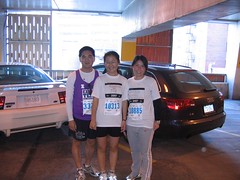
I'm given to understand there is a much better story teller who may be available to you. But, here is my version.
1. Morning - Woken up at 5:00 AM to go to a house fire on the South Side. And by the time I get to the Red Cross, I find out there was a second fire on the North Side. Go and perform damage assessment, case work with clients, and get home around 9:00 AM, and go to bed.
2. Woke up, again, around 12 Noon. Afternoon was with S at a house warming party of a former neighbor of mine (Hi R and T). We ate real well, with home cooked Thai food that I have not had in years. And there were lots of kids running around (they ranged from 21 months to 6 years, yes, they were running). I cooked an apple cobbler for dessert. S played the piano (very happy piano).
3. After being stuffed with Thai food, we went to Phipps Conservatory, where we went to the Chihuly exhibit (glass sculptures in garden [ok, I'll skip some not so necessary details, but the blog post is titled "What I did last Saturday"]). It was open that evening because, well, Chihuly glass sculptures that are lit a night in a gardenare rather romantic-y sort of things, so gardens can make a lot of money with all the couples who like going on walks in lit gardens with beautiful glass sculptures around. Or so I am led to understand (I'm a member, got to understand these things.)
4. When we were done, there was this one sculpture that I suggested might look real nice close up, which would require going outside. Where there was a very handy bench that looked into the proper window.
5. And, yes, said sculpture looked very nice. And I asked S if she would marry me. And I gave her a certain ring that I had in my pocket. Which also looked very nice.
6. Oh, she did say "yes"
Congratulations on making it to the end. And thanks for reading.

